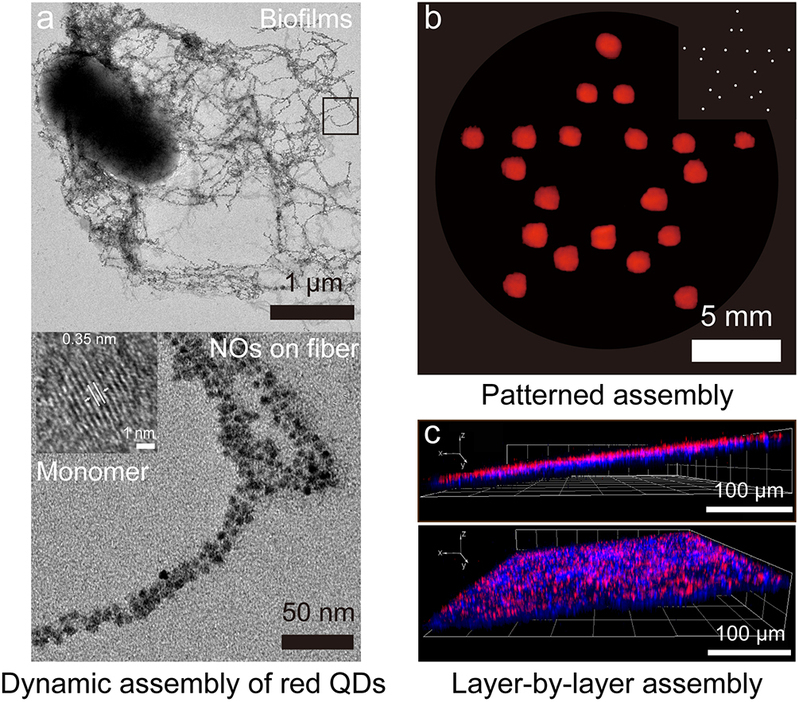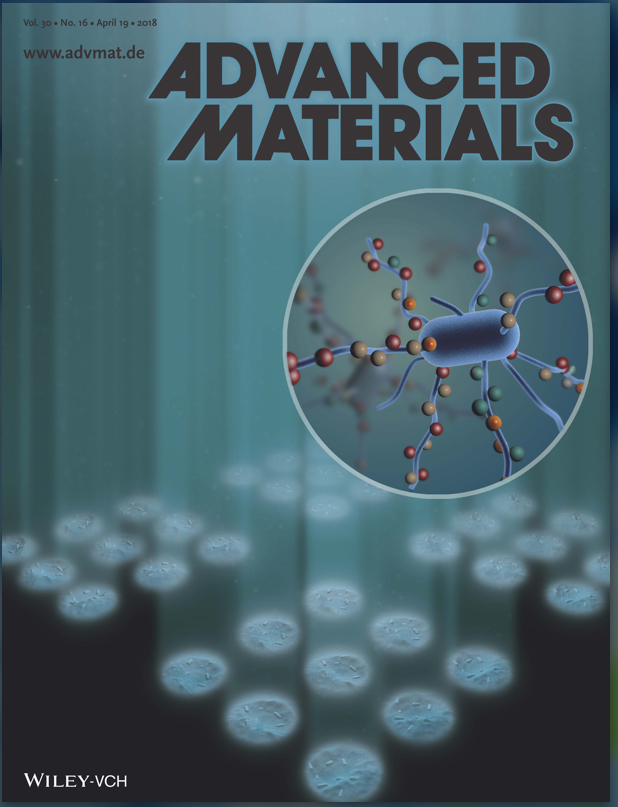Zhong Chao’s Group in the Division of Materials and Physical Biology at ShanghaiTech’s School of Physical Science and Technology (SPST) has recently reported an engineered bacterium, which could sense environmental signals (for example, light or small molecules) to produce biofilms and, and simultaneously direct the assembly of inorganic nano-objects with spatiotemporal control in a dynamic, reconfigurable and scalable fashion. Their exciting results have recently been published in Advanced Materials, a prestigiousinternational journal in the field of materials science. Owing to its broad interest, their communication paper was highlighted as an inside back cover in issue 16 in April, 2018 and has also been recommended by the editors as a highlighted “Video Abstract” on the official website.
Biological self-assemblies are ubiquitous in nature, occurring on scales from the molecular to the organismal. They constitute the basis for structural construction and functional operations of biological nanomachines, materials, and systems. For example, the dynamic assembly of organic and inorganic components, governed spatiotemporally by cells, endows biologically assembled materials such as bones and shells with a structural hierarchy and with functional properties superior to those of their synthetic counterparts. A hallmark of such biological self-assembly system is its dynamic, adaptive, environmentally responsive, and self-replicating nature. These desirable attributes are unattainable with current artificial self-assembly systems. Integrating and harnessing biologically dynamic self-assembly into synthetic self-assembly systems would provide exciting opportunities for producing conceptually new types of materials and nanotechnologies that can be reconfigured on demand, but the pathways to achieve this goal are still undetermined.
By using synthetic gene circuits, they could manipulate cells to link nanoscale objects and curli fibers via metal coordination chemistry and to indirectly guide the assembly of inorganic nano-objects (NOs) onto curli fibers with precise spatiotemporal control. Living biofilms adapt to environmental stimuli (for example, light) and make correlated modifications in their assembled structural states. Their strategy is therefore suitable for creating ordered ensembles of NOs that are reconfigurable on demand. For example, by combining dynamic self-assembly with the intrinsic adherence of biofilms, they accomplished large-scale and hierarchical assembly of discrete NOs or complex heterogeneous structures on substrates of distinct surface functionalities or three-dimensional (3D) materials of complex shapes. Furthermore, by integrating programmed light regulation with a light-sensing strain, they could spatially control cells to assemble curli fibers on desired areas of the substrates in the presence of patterned masks and thereby achieve patterned assembly of quantum dots with a minimum patterning resolution of 100 microns. In addition, by temporally controlling the sequential addition of NOs into the culture, they demonstrated multilayered heterogeneous NO assembly through autonomous layer-by-layer assembly. The complex nanostructures created by their strategy may lead to potential applications in bioelectronics, optoelectronic devices, biocatalysis, wearable and portable devices, smart textiles and energy-relevant. As a proof-of-concept, they demonstrated a touch switch device based on a capacitor constructed from conductive biofilms. In the future, this strategy would be useful to create living functional materials that fruitfully combine the strengths of living systems (e.g., self-repair, ability to sense and respond to complex environments) with those of inorganic systems.
Their work demonstrated the application of synthetic biology tools for manipulating and harnessing biological self-assembly systems to advance a new repertoire of nanotechnologies and materials with increasing complexity that would be otherwise challenging to produce.
Read more:
https://onlinelibrary.wiley.com/doi/epdf/10.1002/adma.201705968
https://onlinelibrary.wiley.com/doi/epdf/10.1002/adma.201870115



